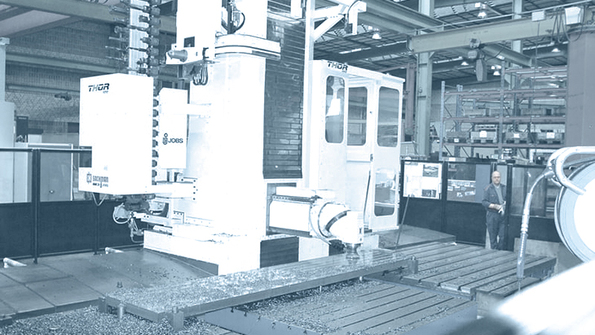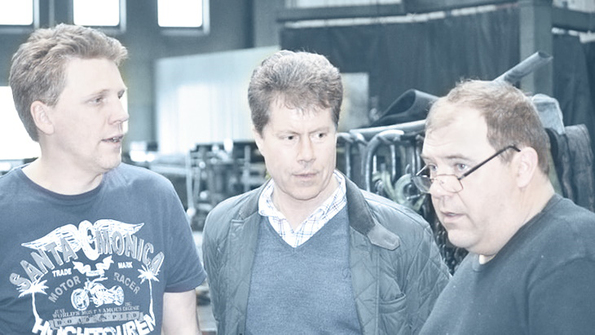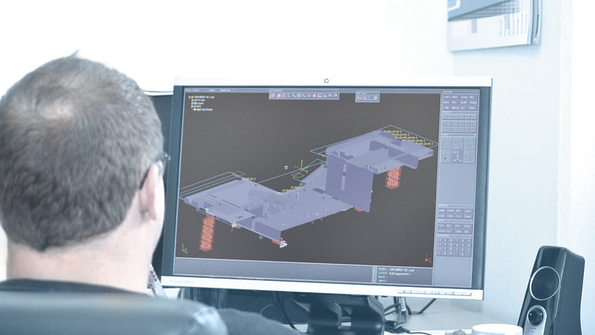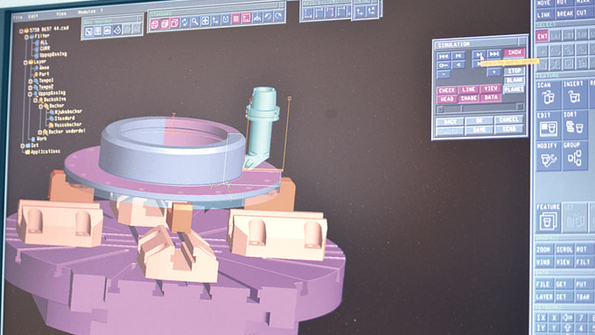Success from switching technologies
MV USAB is a long-established company headquartered in Smedjebacken, Sweden, with more than 150 years in the industry. This tool and machine manufacturer has weathered many reorganizations and reconstitutions over this long period, and in the late 20th century it belonged to the Volvo group of companies for a time. Peter Dahlström, one of the co-owners of MV USAB, is convinced: "We are optimistic that we can successfully continue the 150-year tradition of our company into the future." Because he knows very well how important a suitable CAD/CAM system is today, he and his colleagues decided on Tebis.
Company
MV USAB
Location
Smedjebacken, Sweden
Focus
Fast and reliable 5-axis programs
Benefits:
- Programming with templates
- Comprehensive tool library
- Comprehensive collision checking
Sector
Machinery and equipment
Published
2013

Interviewee: Roger Wadell, Peter Dahlström, Responsible for work preparation and production engineering; co-owner
Tebis helps us prevent collisions that would be disastrous for our operation, especially because our components have a high processing value.
We started with test runs in simultaneous turn-milling, one of the biggest challenges so far, and immediately received helpful support.
One thing has stayed the same at the Swedish company over its many decades in business: the product line. Located in a region of extensive mining, the company – known as Morgårdshammar at that time – specialized in its early years in the manufacture of equipment for mines and rolling mills. Soon they were one of the leading manufacturers of rolling mills and mining equipment in Scandinavia. To this day, technology and machinery designed for the mining sector are a part of the company's core business. In their work, they focus on machining materials like steels, stainless steel and foundry products as well as heat-treatment processes. The company's customers are primarily active in the mining, metal-processing, steel and paper industries.
Modernization
A new CAD/CAM system was needed

"After purchasing the company from the Italian Danieli group in 2004, we focused on a different manufacturing strategy. Instead of series production on small, simple machine centers, we specialized in the manufacture of large and heavy components and finished assemblies in small quantities. We decommissioned many of our older and smaller machine centers and invested in new machinery and equipment. When we purchased a 5-axis machine, we realized that our current CAD/CAM system no longer met our requirements," says Dahlström. "At this point, we began to have problems with the CAM system, and we had major difficulties working with the 5-axis technology," adds Roger Wadell, who is responsible for work preparation and production technologies at MV USAB. "It took a long time to develop a reliable machining process, and the employees in work preparation invested lots of overtime in program development." The company made another large investment in 2011, purchasing two large milling machines, one of which was from Jobs/Sachman (see Fig. 1). It proved very difficult to control the seven axes of the machine using the old CAM system. A new solution had to be found.
The solution
Tebis CAD/CAM

During his research for a new and more powerful CAD/CAM system, Wadell quickly discovered Tebis. Two special strengths attracted his attention: first, the comprehensive tool library where the tools are geometrically described by the Tebis software, enabling comprehensive collision checking with tolerances in the range of the hundredths. The software is capable of describing practically every tool, regardless of its form. The products MV USAB was using at the time were not capable of this. Secondly, there are the machining templates provided for all machining operations, which can be stored and reused when required. The first meeting with Tebis was slightly over one year ago. Mikael Johansson and Per Gisslar from Tebis Scandinavia presented the details of the system to the managers at MV USAB. Discussions with other companies who also use Tebis in working with similar machines and processes resulted in the decision: Tebis is also the right system for MV USAB.
Outstanding
Tebis Support in work preparation and manufacturing

"We started with trial runs on one of our biggest challenges, simultaneous turning and milling, and we immediately received helpful support. Direct support is extremely important for issues involving work preparation, and Tebis and Mikael Johansson in particular met all our expectations. We occasionally faced very difficult challenges, and in these situations we always received competent support from the German contacts," says Wadell. "When the part is clamped in the machine and problems arise, we need help immediately," says Gunnar Persson of MV USAB, who has many years of expertise with CAM systems and programming machine tools.
At the core
A virtual machine with the Tebis Simulator
Error-free manufacturing is always preferred, but since they began specializing in large components in small quantities, MV USAB places enormous value on collision-free production. That’s why the company didn’t just invest in a complete machining function from 2D to 5-axis simultaneous machining and a lathe module. They also acquired a virtual machine for machining planning. Wadell emphasizes how crucial it is for a reliable machining process that CAD programming and simulation performed in the office match the actual machining results in the workshop. Virtual machines reduce the risk of errors. Thanks to the integration of NC simulators in the Tebis process chains, the machinery is realistically mapped in the form of virtual machines.

"We now also have a powerful program for machine simulation. We can avoid collisions that would be disastrous for our operation, especially because our components have a high processing value. We should not simply assume that everything will work all the time, because there are quite a few differences between the CAM systems in the marketplace," says Dahlström. He reports that he is very satisfied with Tebis since the introductory phase, which required some slight adjustments to the code.


